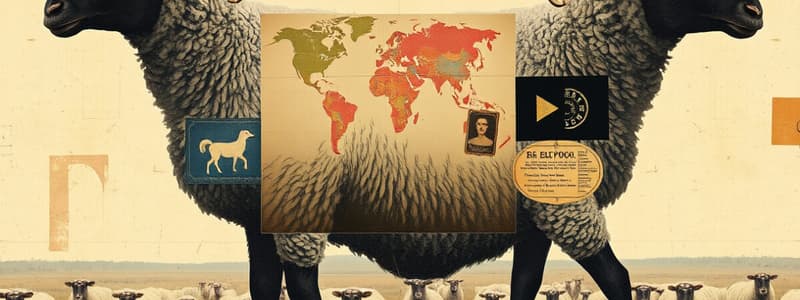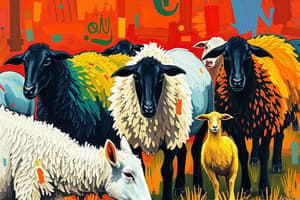Podcast
Questions and Answers
What is the primary reason for the practice of mulesing in sheep?
What is the primary reason for the practice of mulesing in sheep?
Mulesing is primarily performed to reduce the likelihood of flystrike by minimizing the accumulation of dirt and feces in the wool.
What was the significant discovery made by rancher John Mules regarding flystrike?
What was the significant discovery made by rancher John Mules regarding flystrike?
John Mules discovered that removing a patch of skin from a ewe's breech area prevented future flystrike by replacing soiled wool with scar tissue.
As of 2018, what is the status of mulesing in New Zealand?
As of 2018, what is the status of mulesing in New Zealand?
Mulesing was officially banned in New Zealand as of October 1, 2018.
How does mulesing impact the pain experienced by lambs during and after the procedure?
How does mulesing impact the pain experienced by lambs during and after the procedure?
What alternative measures have been sought by Australian sheep ranchers in response to animal rights movements?
What alternative measures have been sought by Australian sheep ranchers in response to animal rights movements?
Describe the geographical origin of the Australian sheep blow fly.
Describe the geographical origin of the Australian sheep blow fly.
What changes were implemented regarding the age of sheep for safe mulesing practice as of 2006?
What changes were implemented regarding the age of sheep for safe mulesing practice as of 2006?
What tools are commonly used in the mulesing procedure today?
What tools are commonly used in the mulesing procedure today?
What is mulesing and why is it performed on sheep?
What is mulesing and why is it performed on sheep?
Which sheep breed is most commonly associated with mulesing practices in Australia?
Which sheep breed is most commonly associated with mulesing practices in Australia?
Why do some organizations support the continuation of mulesing despite its controversy?
Why do some organizations support the continuation of mulesing despite its controversy?
What recommendations does the Australian Veterinary Association make regarding mulesing?
What recommendations does the Australian Veterinary Association make regarding mulesing?
What alternative methods to mulesing do groups like PETA suggest?
What alternative methods to mulesing do groups like PETA suggest?
What is the main purpose of the scar tissue that develops after mulesing?
What is the main purpose of the scar tissue that develops after mulesing?
What was the outcome of the Australian wool industry's promise regarding mulesing in 2009?
What was the outcome of the Australian wool industry's promise regarding mulesing in 2009?
How does mulesing specifically affect flystrike risk on sheep?
How does mulesing specifically affect flystrike risk on sheep?
What is the primary purpose of mulesing in sheep?
What is the primary purpose of mulesing in sheep?
How does mulesing differ from crutching?
How does mulesing differ from crutching?
What are the typical practices that accompany mulesing?
What are the typical practices that accompany mulesing?
What are the opinions of animal rights activists regarding mulesing?
What are the opinions of animal rights activists regarding mulesing?
Why is it important to perform mulesing before the flystrike season?
Why is it important to perform mulesing before the flystrike season?
What is the recommended observation practice for mulesed lambs?
What is the recommended observation practice for mulesed lambs?
What product has been approved for pain relief during the mulesing procedure?
What product has been approved for pain relief during the mulesing procedure?
What have some retailers done in response to concerns about mulesing?
What have some retailers done in response to concerns about mulesing?
What was the consequence of the alleged offer made by Kevin Craig to the Swedish activist regarding Australian wool?
What was the consequence of the alleged offer made by Kevin Craig to the Swedish activist regarding Australian wool?
What did the Swedish Agriculture Minister, Eskil Erlandsson, express regarding Australia's response to international concerns about mulesing?
What did the Swedish Agriculture Minister, Eskil Erlandsson, express regarding Australia's response to international concerns about mulesing?
What condition did some European retailers put in place for lifting their ban on Australian Merino wool?
What condition did some European retailers put in place for lifting their ban on Australian Merino wool?
What were the outcomes of the Australian Wool Innovation's (AWI) pledge regarding mulesing by 2010?
What were the outcomes of the Australian Wool Innovation's (AWI) pledge regarding mulesing by 2010?
Describe the main goal of the alternative mulesing method called 'steining.'
Describe the main goal of the alternative mulesing method called 'steining.'
How does the process of steining differ from traditional mulesing?
How does the process of steining differ from traditional mulesing?
What was one major concern raised by PETA regarding the Australian wool industry and mulesing?
What was one major concern raised by PETA regarding the Australian wool industry and mulesing?
What benefits does the freeze branding technique, or steining, offer compared to traditional mulesing?
What benefits does the freeze branding technique, or steining, offer compared to traditional mulesing?
What were the preliminary findings of Ellen Jongman's study regarding the pain levels of steined compared to mulesed lambs?
What were the preliminary findings of Ellen Jongman's study regarding the pain levels of steined compared to mulesed lambs?
What were the findings of the 2018 study regarding the behavioral markers of pain in lambs?
What were the findings of the 2018 study regarding the behavioral markers of pain in lambs?
Which breeding principles improve flystrike resistance in Merino sheep?
Which breeding principles improve flystrike resistance in Merino sheep?
What was the RSPCA's stance on the breeding of Australian Merino sheep as of July 2021?
What was the RSPCA's stance on the breeding of Australian Merino sheep as of July 2021?
What non-surgical alternatives are being researched for preventing flystrike in sheep?
What non-surgical alternatives are being researched for preventing flystrike in sheep?
How have breeding programs transformed wrinkle-skinned Merino flocks within five years?
How have breeding programs transformed wrinkle-skinned Merino flocks within five years?
What was one of the effective means of protecting sheep from flystrike as identified in early reviews?
What was one of the effective means of protecting sheep from flystrike as identified in early reviews?
What physiological data did Jongman recommend for further research on lamb pain levels?
What physiological data did Jongman recommend for further research on lamb pain levels?
Flashcards are hidden until you start studying
Study Notes
Mulesing Overview
- Mulesing is the removal of wool-bearing skin from the breech of a sheep to prevent flystrike, a parasitic infection from fly larvae.
- The wool in the breech area can trap feces and urine, attracting flies that cause flystrike.
- Scar tissue resulting from mulesing does not attract flies, thereby reducing flystrike susceptibility.
- It is a common practice in Australia, particularly with Merino sheep known for their high wool production.
Mulesing Procedure and Impact
- Considered a skilled surgical task, mulesing can only prevent flystrike in the affected area, not elsewhere on the sheep's body.
- National Farmers Federation of Australia claims that mulesing is the most practical method to prevent flystrike, saving millions of sheep from death.
- The Australian Veterinary Association acknowledges welfare implications but supports mulesing as a necessary practice in the absence of humane alternatives.
Controversy and Animal Rights Perspectives
- Animal rights organizations, including PETA, label mulesing as cruel and advocate for more humane alternatives.
- Australian wool industry previously pledged to phase out mulesing by 2010 but later abandoned this commitment, leading to criticism from animal welfare groups.
- New Zealand's wool industry began phasing out mulesing in 2007, officially banning it by October 2018.
Flystrike and Wool Production Background
- The Australian sheep blow fly, an invasive species, is attracted to Merino sheep due to their wrinkled skin that traps dirt and feces.
- The practice of mulesing originated in the early 1930s when a rancher inadvertently discovered that removing skin reduced fly attraction following healing.
Mulesing vs. Crutching
- Mulesing involves permanent skin removal for flystrike prevention, while crutching is periodic wool removal that does not provide permanent protection.
- Frequent crutching reduces flystrike incidence but is less effective than mulesing.
Pain Management and Regulation
- Mulesing requires accreditation and training for practitioners, typically done during other procedures like tail docking.
- Mulesing causes pain, with no required pre or post-operative pain relief according to Australian law, though analgesics are often applied.
- Codes of practice since 2006 prohibit mulesing in sheep older than 12 months.
Alternatives and Non-Surgical Solutions
- Freeze branding (steining) has emerged as a non-surgical alternative, aiming to prevent wool growth without the same level of pain associated with mulesing.
- Breeding programs focus on creating Merino sheep with less skin wrinkling to reduce flystrike susceptibility.
- Research is ongoing into insecticides, topical treatments, and biological controls to manage flystrike without surgical procedures.
Industry Impact and Fashion Retailer Responses
- Several international retailers, including Abercrombie & Fitch and Liz Claiborne, have boycotted Australian Merino wool due to ethical concerns surrounding mulesing.
- Public and celebrity pressure has intensified the demand for alternatives, leading to research funding for non-mulesing methods.
- Animal welfare groups advocate for a focus on breed modification and dietary interventions to minimize flystrike risk without surgical intervention.
Studying That Suits You
Use AI to generate personalized quizzes and flashcards to suit your learning preferences.



